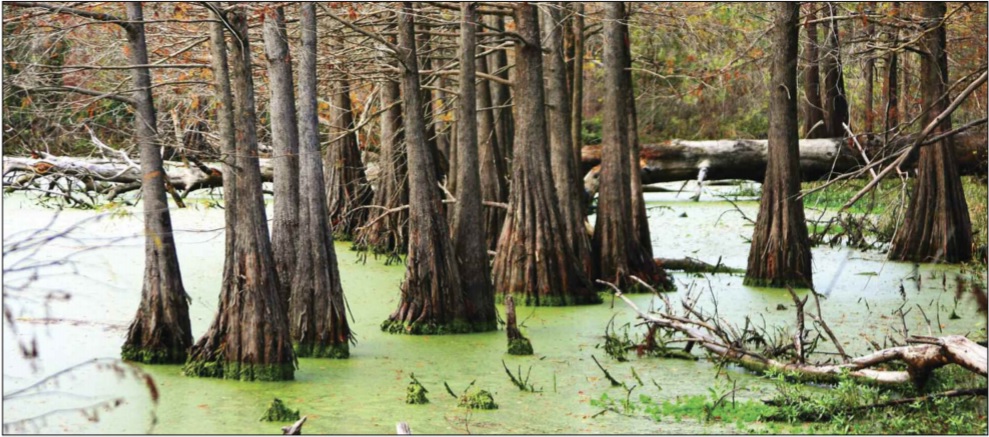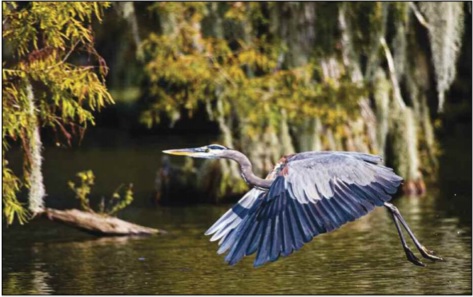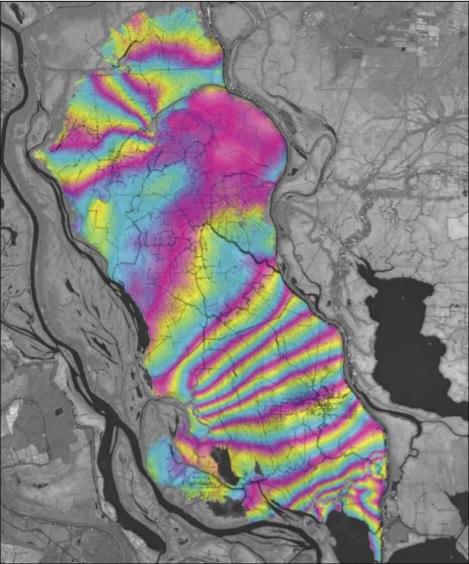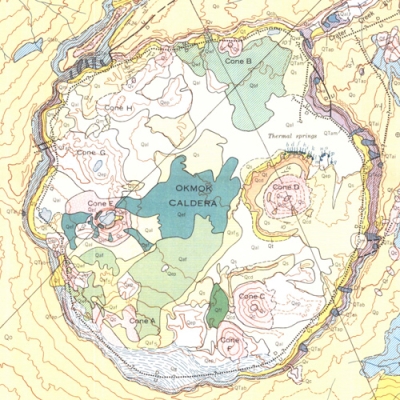In the mid-1950s, two geologists surveyed the terminus of the majestic Mississippi River, the seemingly endless stretch of interconnected swamps, bayous, and muddy land that comprises southeastern Louisiana. In their report to the United States Army Corps of Engineers, Charles Kolb and Jack Van Lopik described the delta as “a land between Earth and sea—belonging to neither and alternately claimed by both.”
Five decades later, southeastern Louisiana remains in this timeless tug of war between land and water. Residents continue to bury their dead above ground and safe from the shallow water table. In New Orleans, twenty pumping stations drain the land of 85 billion liters (22.5 billion gallons) of water each day. However, the massive artificial levees built to protect communities from seasonal flooding have instead caused the land to be more vulnerable to water. Scientists say the 560 kilometers (350 miles) of levees prevent the river from replenishing the delta with new sediment, causing parts of the land to sink further below sea level. This, and the increase in flooding, have left communities extremely vulnerable to damage from hurricanes, such as Hurricane Katrina in 2005.
Zhong Lu, a physical scientist at the Earth Resources Observation and Science (EROS) Data Center in Sioux Falls, South Dakota, was drawn to the delta’s unique, if complex, geological processes. Lu was interested in land subsidence, or the sinking of the Earth’s surface in response to geologic or human-induced causes. Lu said, “I wanted to make a map of how land was sinking in and around the New Orleans area using remote sensing. Instead, I saw interesting signals from the delta’s swamps and marshes.” Lu suspected he had found a more efficient way to detect water-level changes, a process that is crucial to flood hazard modeling and wetland management in the delta.
Lu was interested in land subsidence, or the sinking of the Earth’s surface in response to geologic or human-induced causes. Lu said, “I wanted to make a map of how land was sinking in and around the New Orleans area using remote sensing. Instead, I saw interesting signals from the delta’s swamps and marshes.” Lu suspected he had found a more efficient way to detect water-level changes, a process that is crucial to flood hazard modeling and wetland management in the delta.
Watching the delta sink
Lu was a volcano man; his expertise was volcano deformation mapping and monitoring using satellite imagery. More importantly, Lu specialized in a remote sensing technique highly favored in geologic and geophysical research. Satellite-based synthetic aperture radar (SAR) rapidly shoots beams of radar waves towards the Earth and records them after they bounce back off the Earth’s surface. Image maps are made from these signals, and experts combine two such maps of the same area, taken at different times. The resulting image, called an interferogram or InSAR, uses color to show how parts of a land surface—around a volcano, for example—have moved. “This is why the technique is primarily associated with the study of volcanoes, earthquakes, and land subsidence,” Lu said.
However, it was not difficult for Lu to shift from volcanoes to looking at the delta’s sinking land, and then to studying its swamps and marshes. “I am very interested in exploring the use of InSAR on broad geophysical, geological, as well as hydrological problems,” he said. “If we can demonstrate that the technique can measure water-level changes, it would be a great discovery. It could improve accuracy in flood hazard modeling and assessment.”
Stephen Faulkner, an ecologist at the National Wetlands Research Center in Lafayette, Louisiana, said that monitoring water levels is crucial not only in flood hazard modeling but also in wetland ecology and management. Scientists need long-term records of water levels to understand how swamp forests can regenerate under changing conditions. Faulkner said, “Coastal Louisiana has changed a lot over the last hundred years. There has been a lot of subsidence and coastal land loss, and the hydrology has changed across entire landscapes, resulting in longer and deeper flooding. When the water is too deep for too long, even flood-tolerant trees like bald cypress and water tupelo cannot regenerate.” Some forested wetlands turn into areas with smaller or no vegetation or are converted to permanent open water. This is a concern because logging of bald cypress and water tupelo forests in the deep water areas will accelerate the loss of these forests and the ecosystem services they provide.
On a larger scale, scientists say the entire delta will continue to sink at a rate of 5 to 10 millimeters (0.19 to 0.39 inches) and lose 6,500 hectares (16,000 acres) of wetlands each year. But accurate and long-term water-level measurements can help experts identify areas suitable for either artificial or natural regeneration and protect some wetland areas from complete loss.
Under the canopy
Scientists have used in situ gauge measurements in wetlands to assess flood hazards and record water level changes. Lu said, “But this method is cost prohibitive. Insufficient measurements cause significant errors in hydrologic simulations. Satellite sensors can be a cost-effective tool to monitor water-level changes. Satellites take measurements more frequently and cover a wider area.”
Lu wanted to know if the InSAR remote sensing method for studying land deformation could detect water-level changes in wetlands. He focused his study on southeastern Louisiana, an area that encompasses almost 40 percent of the coastal wetlands of the lower forty-eight United States. Wetlands are transitional areas that are sandwiched between permanently flooded deepwater environments and well-drained uplands. They buffer the land from storms and floods. In Louisiana, wetlands include swamps, mangroves, marshes, and bogs, all fed with fresh water and sediment from the Mississippi River and salt water from the Gulf of Mexico. Muskrats, otters, minks, and alligators inhabit these soggy wetlands. Crawfish burrow in the mud, and bald cypress and water tupelo trees form green canopies over the remaining swamp forests. Could radar waves even penetrate a swamp forest canopy enough to get bounced off water and back to the satellite? Would the technique work, considering the large variety of vegetation that the radar waves had to penetrate to get bounced off of water?
Penetrating a swamp forest
Lu recalled that Doug Alsdorf, a hydrology expert and professor at the School of Earth Sciences at Ohio State University, demonstrated in 2000 that radar waves could bounce off water underneath the thick and tall forest canopy of the Amazon River in South America. Alsdorf had used L-band radar signals with a wavelength of 24 centimeters (9.4 inches). Lu had been using C-band signals with an even shorter wavelength when he accidentally picked up interesting signals from the delta’s swamp forest. “I asked myself, can SAR C-band images be used to monitor water-level changes?” Lu said.
First, Lu needed to find out if C-band radar waves could penetrate the vegetation and if their backscattering behaviors would characterize vegetation in the study area. To do this, Lu and his colleague Oh-Ig Kwoun consulted maps and determined that southeastern Louisiana had six major classes of vegetative cover: bottomland forests, swamp forests, freshwater marshes, intermediate marshes, brackish marshes, and saline marshes. They then compared these classes to data from Synthetic Aperture Radar (SAR) sensors on the RADARSAT-1 satellite, distributed by NASA's Alaska Satellite Facility (ASF) Distributed Active Archive Center (DAAC), and from the European Remote Sensing (ERS) satellites ERS-1 and ERS-2. “The data showed that SAR signals can be used to classify existing vegetation over wetlands,” Lu said. “Multiyear and season-averaged observations would provide more robust results.”
With an idea of how C-band radar behaves over different kinds of wetland vegetation, Lu and Kwoun generated interferograms. They found that a specific C-band wavelength of 5.66 centimeters (2.2 inches) was suitable for producing InSAR images from the moderately dense tree canopies and other vegetation in Southeastern Louisiana. Lu said, “The images had an unprecedented degree of vertical accuracy. InSAR can indeed be used to estimate water-level changes. But there are limitations, so we have more questions to explore.”
Tools for precision
One of these limitations is that the technique requires the presence of vegetation in the water to allow radar pulses to be bounced back to the sensor. So during intense flooding where the water is higher than the vegetation, InSAR is useless. Another limitation is that water-level changes differ from point to point. In an ideal situation, water flows placidly over a symmetrical, smooth surface devoid of obstruction. But southeastern Louisiana’s wetlands have barriers, such as levees. Measurements from gauge stations are still required to calibrate SAR measurements.
Alsdorf, whose work on L-band radar encouraged Lu to pursue his own research questions regarding InSAR and wetlands, said that scientists have a long way to go in finding out how much water exists at any one place at any point in time. Alsdorf said, “In the world of surface water hydrology, we have sparse measurements and knowledge of how much water is on the planet at any one place or time, But the exciting thing about Lu’s work is that in certain cases like the Louisiana swamp forest, C-band will penetrate a particular forest canopy. We are talking about trying to use highly specialized tools—the C-band satellite for one location, the L-band satellite for another location—to piece together how water is flowing through these wetland environments. That is exciting scientific work.”
To preserve and protect
As Lu resolves the limitations of the technique, more scientists are recognizing possibilities for using InSAR in understanding the delta’s hydrology. In Louisiana, Faulkner is compiling in situ measurements from the Atchafalaya Basin to confirm SAR data. A science working group has recognized the importance of remotely sensed data in studying the delta’s changing hydrology. In their report to the Governor, the Coastal Wetland Forest Conservation and Use Science Working Group said, “Adding remotely sensed data . . . should be aggressively pursued. Such data are critical to wisely manage and care for the coastal forest wetland system of Louisiana.”
Lu plans to improve his methods by using other remote sensing data, such as data from the NASA Ice, Cloud, and Elevation Satellite (ICESat), to refine estimates on absolute water changes. He may also use data from a radar altimeter to provide temporal and spatial variations of water-level height. Lu said, “I have been using InSAR for ten years to study volcanoes and earthquakes. But personally, I feel that I learned more when I looked at this question.” Lu is not leaving his field of specialty, but he is hopeful that his discovery will help in the preservation of the delta’s wetlands and in the protection of communities that have chosen to make southeastern Louisiana their home.
References
Alsdorf, D., J. Melack, T. Dunne, L. Mertes, L. Hess, and L. Smith. 2000. Interferometric radar measurements of water level changes on the Amazon floodplain. Nature 404: 174–177.
Faulkner, S. P., J. L. Chambers, W. H. Conner, R. F. Keim, J. W. Day, E. S. Gardiner, M. S. Hughes, S. L. King, K. W. McLeod, C. A. Miller, J. A. Nyman, and G. P. Shaffer. 2007. Conservation and use of coastal wetland forests in Louisiana. In Ecology of Tidal Freshwater Forested Wetlands of the Southeastern United States , eds. W. H. Conner, T. W. Doyle, and K. W. Krause, 447–460. The Netherlands: Springer.
Lu, Z. Interferometric Synthetic Aperture Radar past, present and future. https://www.researchgate.net/publication/242137872_Interferometric_Synthetic_Aperture_Radar_InSAR_Its_Past_Present_and_Future
For more information
NASA Alaska Satellite Facility Distributed Active Archive Center (ASF DAAC)
USGS National Wetlands Research Center
| About the remote sensing data | ||
|---|---|---|
| Satellite | RADARSAT-1 | |
| Sensor | Synthetic Aperture Radar (SAR) | |
| Data set | C band | |
| Resolution | 10 to 100 meter | |
| Parameter | Water level | |
| DAAC | NASA Alaska Satellite Facility Distributed Active Archive Center (ASF DAAC) | |



